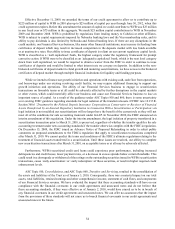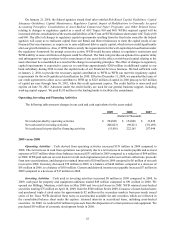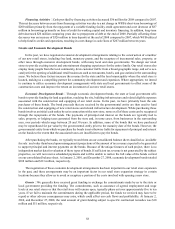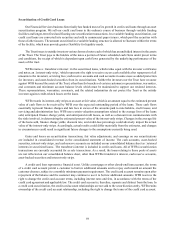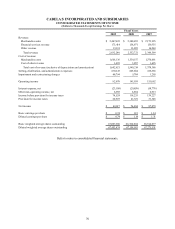Cabela's 2009 Annual Report Download - page 72
Download and view the complete annual report
Please find page 72 of the 2009 Cabela's annual report below. You can navigate through the pages in the report by either clicking on the pages listed below, or by using the keyword search tool below to find specific information within the annual report.63
Our estimation processes contain uncertainties because they require management to make assumptions and apply
judgment to make these estimates. Should actual results be different than our estimates, we could be exposed to gains
or losses from differences that are material.
For a summary of our significant accounting policies, please refer to Note 1 of our consolidated financial
statements. We believe the accounting policies discussed below represent accounting policies we apply that are the
most critical to understanding our consolidated financial statements.
Merchandise Revenue Recognition
Revenue is recognized on our Internet and catalog sales when merchandise is delivered to customers at the
point of delivery, with the point of delivery based on our estimate of shipping time from our distribution centers
to the customer. We recognize reserves for estimated product returns based upon our historical return experience
and expectations. Had our estimate of merchandise in-transit to customers and our estimate of product returns been
different by 10% at the end of 2009, our operating income would have been higher or lower by approximately $0.5
million. Sales of gift instruments are recorded in merchandise revenue when the gift instruments are redeemed
in exchange for merchandise and as a liability prior to redemption. We recognize breakage on gift instruments as
revenue when the probability of redemption is remote. Had our estimate of breakage on our recorded liability for gift
instruments been different by 10% of the recorded liability at the end of 2009, our operating income would have been
higher or lower by approximately $0.5 million.
Inventories
We estimate provisions for inventory shrinkage, damaged goods returned values, and obsolete and slow-moving
items based on historical loss and product performance statistics and future merchandising objectives. While we do
not believe there is a reasonable likelihood there will be a material change in the future impacting these estimates,
actual losses can be higher or lower based on future merchandising decisions and retail economic trends. Had our
estimated inventory reserves been different by 10% at the end of 2009, our cost of sales would have been higher or
lower by approximately $1 million.
Catalog Costs
Deferred catalog costs consist of incremental internal and third-party direct costs incurred in the development,
production, and circulation of our direct mail catalogs, composed principally of creative design, prepress/production,
paper, printing, postal, and mailing costs. Deferred catalog costs are amortized over their expected period of future
benefit or twelve months, whichever is shorter, based upon sales forecasts developed using historical sales for similar
catalog offerings. Deferred catalog expenses are evaluated for recoverability at each reporting period by comparing
the carrying amount associated with each catalog to actual sales data and to projected future cash flows. Had our
amortization estimate of deferred catalog costs been different by 10% for 2009, our catalog costs expense would have
been higher or lower by approximately $2.6 million.
Economic Development Bonds
We recognize economic development bond investments based on estimates of the discounted future cash
payments to be received under these bonds. These estimates are also the basis for our recognition of deferred grant
revenue to be received under the economic development grants as an offset to construction costs which is amortized
over the asset lives of the development. These cash flow estimates are dependent on property and/or sales tax
collections derived from our operations, and potentially other businesses, some of which may be in the development
stage. Had our fair value estimates been lower by 10% as of the end of 2009, the value of economic development
bonds reflected in our consolidated financial statements would have been approximately $11 million less with the
unrealized loss reflected in comprehensive income (loss) if the loss was deemed to be temporary. Any declines in the
fair value of held-to-maturity and available-for-sale economic development bonds below cost that are deemed to be
other than temporary are reflected in earnings as realized losses. Gains and losses on sales are recorded on the trade
date and determined using the specific identification method.



